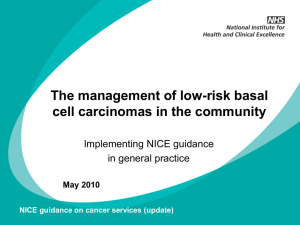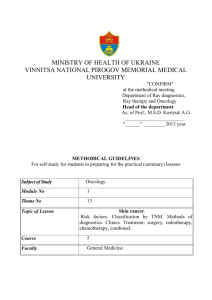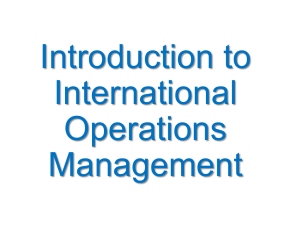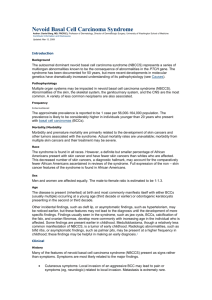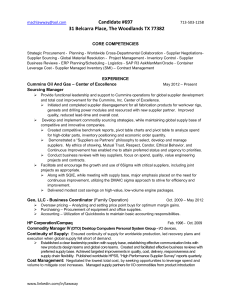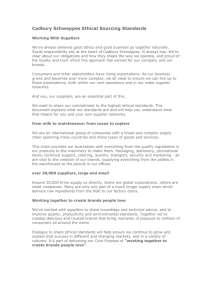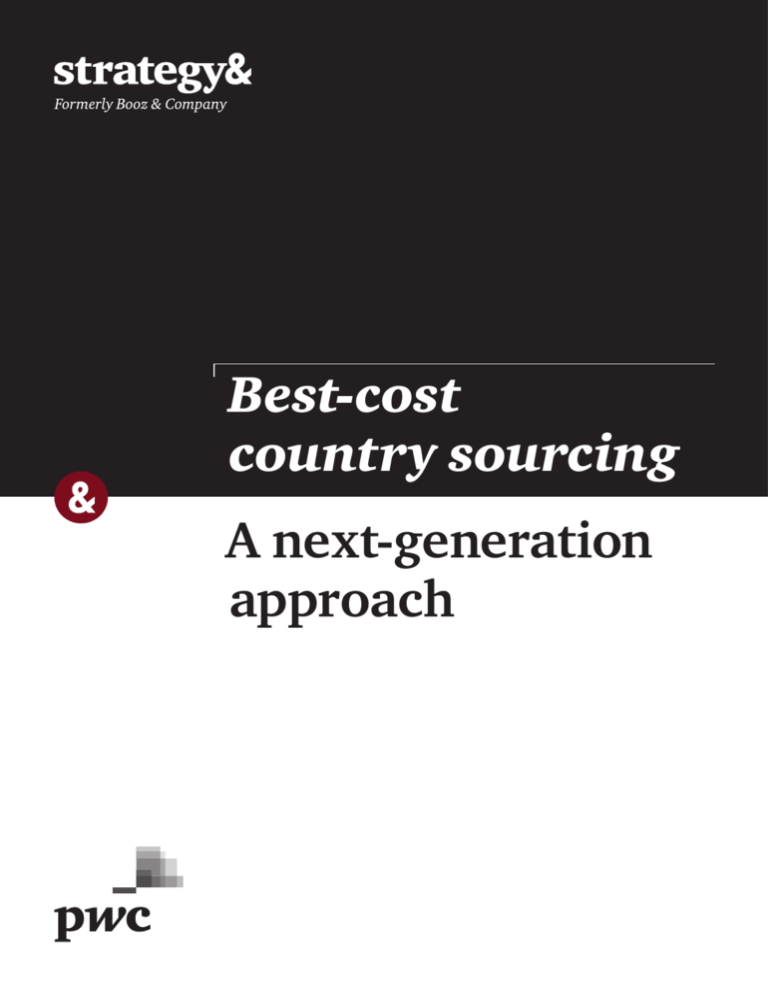
Best-cost
country sourcing
A next-generation
approach
Contacts
Amsterdam
London
Munich
São Paulo
Marco Kesteloo
Partner
+31-20-504-1942
marco.kesteloo
@strategyand.pwc.com
John Potter
Partner
+44-20-7393-3736
john.potter
@strategyand.pwc.com
Anna Mansson
Principal
+49-89-54525-579
anna.mansson
@strategyand.pwc.com
Fernando Fernandes
Partner
+55-11-5501-6222
fernando.fernandes
@strategyand.pwc.com
Beirut
Dave Phillips
Principal
+44-20-7393-3715
dave.phillips
@strategyand.pwc.com
New York
Vienna
Martha Turner
Partner
+1-212-551-6731
martha.turner
@strategyand.pwc.com
Harald Dutzler
Partner
+43-1-518-22-904
harald.dutzler
@strategyand.pwc.com
Gabriel Chahine
Partner
+961-1-985-655
gabriel.chahine
@strategyand.pwc.com
Düsseldorf
Peter Heckmann
Partner
+49-211-3890-122
peter.heckmann
@strategyand.pwc.com
2
Mexico City
Carlos Navarro
Partner
+52-55-9178-4209
carlos.navarro
@strategyand.pwc.com
Strategy&
About the authors
Harald Dutzler is a partner with Strategy& based in Vienna. He
specializes in cost transformation and efficiency improvements,
especially in sourcing and supply chain management. He has worked
with numerous industries, most notably consumer goods and retail.
Dave Phillips is a Strategy& principal based in London. He specializes
in strategic operations and sourcing issues for clients in consumer and
retail industries.
Anna Mansson is a principal with Strategy& based in Munich. She
specializes in strategic sourcing for the automotive, aerospace, and
consumer industries.
Sriram Parthasarathy was formerly an associate with Strategy&.
This report was originally published by Booz & Company in 2011.
Clemens Bauer, Angela Dum, Stephen Li, Michael Oldermann, Ramon Tenge, and
Robert Weissbarth also contributed to this report.
Strategy&
3
Executive summary
Best-cost country sourcing (BCCS), the traditional sourcing approach,
has been on the agendas of chief procurement officers in the consumer
goods and retail industries for quite some time. However, in the past,
the notion of BCCS was often driven primarily by labor-cost arbitrage
opportunities, with a focus on sourcing labor-intensive products or
parts at the lowest total cost of ownership. Today, a number of factors
necessitate a change in this approach to best-cost country sourcing.
As consumer markets explode in emerging economies — especially
in Asia, and in South America as well — it becomes very clear that
BCCS is mandatory for global success. But these days, global sourcing
strategies are influenced by new forces that change the equation
somewhat. Among them: inflationary pressure on wages in emerging
markets, shifting currency values, an increasing focus on greener supply
chains, greater emphasis on increasing speed-to-market, regulatory
compliance concerns, logistics costs, and scheduling, as well as the
unique preferences and demands of emerging consumer markets. To
get BCCS right, these issues and opportunities must be dealt with and
accounted for in new and innovative ways with total cost of ownership
in mind. Leading consumer goods and retail companies rank at the top
of BCCS practitioners — and they continue to find new ways to deal
with unfolding BCCS challenges and opportunities.
Using insights into prevailing BCCS practices across industries, we share
our perspective on how companies are taking their BCCS initiatives
forward. In order to provide a guideline for evaluating an organization’s
BCCS practices, we have identified three sourcing maturity levels:
Novice, Progressing, and Best in Class. We provide a questionnaire
for determining your company’s level. For each maturity level, we
offer specific steps that will improve your BCCS strategies and your
company’s overall competitive position in today’s increasingly
globalized and dynamic BCCS environment.
4
Strategy&
BCCS reevaluated
Best-cost country sourcing has long been a strategic priority for the
consumer goods and retail industries. For many years, it has been far
too expensive to purchase and assemble products in the West, no matter
the destination of the final item. This is particularly true for companies
whose profit margins are relatively thin. Indeed, the cost benefits from
BCCS — through either suppliers or proprietary plants — are well
established. Historically, total cost of ownership (TCO) savings have
been as high as 30 percent for apparel, 20 percent for housewares and
kitchenware, and 20 percent for electronics (see Exhibit 1, next page).
However, these cost benefits are likely to shrink without a reevaluation
of BCCS strategies. Some of the factors in TCO calculations — which
consider not only wages and compensation but also real ancillary
costs, such as the price of compliance with social and environmental
regulations, logistics, and currency volatility, among other things —
are becoming more expensive. For one thing, companies can no longer
avoid the price of implementing green initiatives virtually everyplace
they do business, to show customers that they are good global citizens
as well as to reduce emissions in the supply chain, abide by local rules,
and minimize the possibility of a costly accident. The price of oil and
other logistics costs are likely to remain volatile in the next few years.
Such uncertainty only adds to the risks involved in shipping products to
developed markets from suppliers in emerging nations, the traditional
best-cost countries.
Moreover, although lower salaries in countries considered best-cost
might today still make up for the associated add-on costs of sourcing
products from a best-cost country, wages in these countries are on the
rise. In China, many companies are offering workers raises of 30 to
70 percent. India’s wage inflation is close to 11 percent per year. And
violent protests by textile workers in Bangladesh last year persuaded
the government to almost double the minimum wage.
Hence, as the ground shifts in the calculus of traditional BCCS
strategies, companies must begin to revisit their approach to BCCS
and take the next steps in its evolution to ensure sustainable benefits.
Strategy&
5
Exhibit 1
Cost reduction has been the main reason for BCC sourcing
Total cost of ownership gains by product
(transfer of production from Western Europe to China)
Product
6
Total potential
cost reduction
Textiles & apparel
15%–30%
Housewares/kitchenware
15%–20%
Injection molded plastics
12%–20%
Electronics
15%–20%
Source: Strategy&
Strategy&
Out of this reevaluation, the scope and contours of BCCS programs are
already changing markedly. Examples include the following:
• The Coca-Cola Company plans to pump more than US$5 billion into
its Mexican bottling operations over the next five years, in part to
fund a series of environmental initiatives designed to meet rigorous
sustainability targets related to water usage. This is just one of many
water conservation programs that Coke’s Latin American bottlers are
undertaking.
• A few years ago, apparel maker Tommy Hilfiger Group sold its
global sourcing operations to Hong Kong–based Li & Fung, the huge
consumer products development and distribution outfit. Li & Fung
also manages sourcing operations for retailers such as Walmart and
Arcandor as well as consumer goods providers such as Liz Claiborne
and the Jackel Group. These companies hope to realize significant
cost savings by entrusting their global supply chains to specialist
operators that can operate at high levels of scale.
• Several large consumer electronics companies are actively building
a supply chain and supplier base in western China. Although labor
rates are somewhat lower in this still developing, semirural region,
the main goal of this effort is not just to reduce cost, but rather to
reduce lead times for shipments to the expanding customer base in
the area and to respond more quickly to consumer demands.
In this dynamic environment, the choice of the best-cost country for
consumer goods and retail companies should be based not only on
a static view of TCO but also on accurate forecasts of future costs,
alternative growth markets, and approaches to implementing greener
and leaner supply chains. In short, if companies are to thrive, they need
to generate new blueprints for sustaining cost advantages in a rapidly
changing world. To address this challenge, companies are taking these
tactical steps:
1. Developing “unique” capacities within best-cost countries: Rather
than focus on best-cost countries per se, some companies (leading
consumer goods companies in particular) are targeting competitive
suppliers, those that will retain their market advantages even if
macroeconomic conditions change. Indeed, some companies are
leveraging capabilities in supplier development in emerging
economies not only for cost- and efficiency-related programs but
also for product design and development. For example, a European
company seeking a supplier for a wide range of plastic products
persuaded a leading plastic processing machinery manufacturer in
a best-cost country to expand its business model by developing the
capacity to produce actual plastic end products. By helping the
Strategy&
7
supplier develop these new capabilities, the company was able to lock
in a reliable source and design partner for a critical set of products at
a price that was extremely competitive.
2. Looking for alternative destinations: In a strategy that is typically
described as finding alternatives to China, consumer goods
companies have for some time been moving to lower-cost countries
like Bangladesh, Vietnam, Cambodia, and some parts of Africa. And
in Europe, Poland and the Czech Republic are being challenged by
Romania and some of the Baltic states. This approach is sometimes
problematic because with everybody looking for the next best lowcost alternative at the same time, production capacity in these new
regions can be hard to find. Companies must demonstrate a high
level of expertise in rapidly mapping, evaluating, and locking in
attractive capacity in different BCCS locations. This tactic also calls
for considerable skills in assessing which destinations are truly best
after factoring in some of the likely future macroeconomic conditions
and social and environmental obligations.
3. Manufacturing the final product closer to the market: A number
of consumer goods companies have opted to move a portion of
production to eastern Europe, hoping to tap into high-growth
markets, particularly in Russia and other eastern European nations.
Further, the proximity to major markets in western Europe, which
in turn lowers logistics costs and contributes to a greener and
more efficient supply chain, makes this region more desirable than
traditional best-cost countries in Asia. Of course, as organizations
seek to expand in emerging markets, like China and Brazil, the
ability to develop country-specific products in nearby best-cost
countries will be critical.
4. Creating a green, sustainable strategy: The need to reduce “merchandise
miles” and the overall focus on greener supply chains have led many
consumer goods and retail companies to develop innovative strategic
approaches to BCCS. In general, these companies balance “low cost”
and “best cost” in an environmental context. For example, IKEA plans
to double its Indian sourcing volume to €500 million (US$710 million)
over the next five years and hopes to eventually open stores in India.
As a part of its BCCS initiative, the Swedish retailer has teams of social
and environmental specialists in all best-cost countries. These teams
work closely with suppliers not only to ensure compliance with IKEA’s
social and environmental standards but also to educate suppliers,
particularly in agricultural sectors, about more sustainable production
and packaging techniques.
8
Strategy&
Best in class: A case study
A large European retailer is a good
illustration of the type of best-cost
country sourcing program necessary
to stay ahead of dynamic business
conditions. An early entrant into
BCCS — its first program was some
30 years ago — the retailer began with
simple labor cost arbitrage sourcing;
since then, the company’s BCCS
strategy has evolved to include TCO
models, the imposition of social and
environmental compliance among its
suppliers, well-structured supplier
development programs, and supply chain
optimization. Currently, the retailer is
focusing on these two critical elements
of a BCCS strategy:
Sustainability in BCCS: The organization
has made a public commitment to use
only cotton grown under sustainable
practices in the textile products it sells.
In order to implement this organic,
water-conserving approach, the
retailer has dedicated internal teams of
agriculture experts to work directly with
cotton farmers, primarily in India and
Pakistan.
Flexible sourcing: Because of cost
escalation in China, the retailer is
adopting a scenario-driven BCCS
strategy that could seamlessly shift
sourcing volumes from one best-cost
Strategy&
country to another, depending on
macroeconomic conditions. By mapping
scenarios for market growth, currency
moves, inflation, and a number of other
factors, the retailer is endeavoring
to configure its supply networks to
respond to different eventualities.
For example, one alternative would
be to produce items in eastern Europe
from components sourced in China.
To facilitate this, the retailer is making
significant investments in surplus tools
for eastern European factories; it will
then have the flexibility to reallocate
volumes quickly if needed. A scenariodriven formula for BCCS requires a high
degree of analytic rigor and substantial
familiarity with a number of markets.
And although such an approach may
be time-consuming to implement,
recent supply chain disruptions in
Japan as a result of the massive tsunami
demonstrate how vital the need is to
mitigate risk.
Clearly, this retailer regards BCCS
as a key element in developing a
competitive value proposition. And as
the organization expands its presence
in emerging markets, it continues to
increase its sourcing from BCCs, but with
an approach that embeds sustainability
and volatility as key drivers for BCCS
decisions.
9
Novice, Progressing,
Best in Class?
Given the volatile dynamics of BCCS, it is imperative for consumer and
retail companies to reassess their sourcing maturity level and prepare to
upgrade their BCCS initiatives to better respond to the new conditions.
Many companies have consciously improved their BCCS capabilities
over the past few years, but few companies are thus far exploiting their
full potential; many are having difficulty sustaining the competitiveness
of their BCCS strategies.
In our view, there are three BCCS maturity levels: Novice, Progressing,
and Best in Class. An organization’s level can be determined by its
responses to questions about its current practices and experience
(see Exhibit 2, next page).
Novice: If the test identifies you as a Novice, you may have only started
the journey toward BCCS. In fact, you probably have a developing BCCS
program but still lack clearly defined targets. Most frequently, Novice
companies make BCCS decisions without a TCO approach that takes
into account all relevant cost dimensions and associated risks.
Progressing: If you’re a Progressing company, a sound TCO approach
is integral to your BCCS practice, and your suppliers are encouraged
to procure parts and materials from best-cost country–based subsuppliers. The greatest challenge for many Progressing companies is
to develop manufacturing facilities and a supply base in emerging
nations with a strategic sourcing view — that is, with the capabilities
to assess the local market for real, long-term sourcing opportunities —
rather than focusing only on more immediate tactical sourcing.
Best in Class: As a Best in Class company, you are actively exploring
innovative supply networks consisting of unique best-cost suppliers
in true best-cost countries. You have a strong supplier development
organization in those countries. You are able to gain more control over
your supply chain in the best-cost countries by directly contracting with
the producers for certain raw material, particularly agricultural raw
material, such as cotton, wheat, and cocoa. You are also thinking of
innovative ways to optimize the entire supply chain to offset recent
10
Strategy&
Exhibit 2
Assessing your BCC sourcing maturity level
Questionnaire for maturity level assessment
Part A
Part B
Yes No
1. You have a clear vision for BCC sourcing
and have set clear targets for sourcing
from BCCs
2. You have moved at least 10% of your total
procurement spend to BCCs
3. You have based your BCC sourcing
decisions on a clear set of criteria and
have implemented a structured approach
(e.g., TCO)
4. You have been consistently encouraging
your Western suppliers to develop a BCC
footprint
5. You have established procurement offices
in BCCs that can at least carry out tactical
sourcing
6. You have capabilities in key BCC markets
to assess the local supply base and identify
sustainable sourcing opportunities and
potential long-term partners
7. BCC suppliers that have stable business
with you are regularly receiving new RFQs
and winning new business
If <6 Part A
questions are
answered with “Yes”
Novice
If ≥6 Part A
questions
are answered
with “Yes”
Yes No
1. You have moved more than 40% of total procurement spend to
strategically prioritized best-cost suppliers in best-cost countries
2. You source more than 70% locally for production in BCCs
3. You are undertaking significant sustainability-related initiatives
together with your key suppliers in BCCs
4. You are now configuring BCC supply networks (across several
BCCs), which allow you to seamlessly shift volumes to different
suppliers based on various macroeconomic and other scenarios
5. You have certified local sources for all relevant raw materials in BCCs
6. You have mature procurement capabilities on-site in BCCs
(e.g., tactical, technical, strategic)
7. You have established cross-functional skills and capabilities on-site
in BCCs (e.g., product development centers, supplier development
teams)
8. Your BCC sourcing targets are shared among purchasing, product
range development, and business unit management
9. You are able to contract directly with suppliers in BCCs and avoid
middlemen and agents
10. You have dedicated teams on-site to improve and monitor social
and environmental compliance at suppliers and even sub-suppliers
11. You have a logistics concept in place in emerging markets to
optimize transport and inventory costs
12. You are selectively grooming some BCC suppliers to become
development partners
If <9 Part B
questions are
answered with “Yes”
Progressing
If ≥9 Part B
questions are
answered with “Yes”
Best in Class
Source: Strategy&
cost increases in best-cost locations: for instance, acquiring a
combination of manufacturing components (even high-value
components) in best-cost countries and shipping them to eastern
Europe, where they can be assembled for sale in major European
markets. You have also developed a sustainability program that
extends to all your best-cost country suppliers.
Given the emerging opportunities and complexities of BCCS, it is
becoming increasingly important for consumer goods and retail
companies to upgrade their BCCS capabilities to the next level of
maturity. To facilitate this effort, we have compiled a set of best
practices (see Exhibit 3, next page).
Strategy&
It is becoming
increasingly
important
for consumer
goods and retail
companies
to upgrade
their BCCS
capabilities.
11
Exhibit 3
BCC sourcing maturity framework
Novice
Progressing
Best in Class
– Use the best-practice areas for “doing it
– Focus on optimizing the already-existing
– Focus on optimizing cost for the alreadyexisting BCC sourcing
– Focus on developing a supply chain
concept, and start building the
organization
– Emphasis on:
– How to develop suppliers
– How to optimize the integrated supply
chain
– Further developing the local organization
– Emphasis on:
– How to optimize the integrated supply
chain
– Creation of a low-cost platform
– Management of supply market
dynamics
right the first time”
BCC approach
1
Create an overall
supply chain concept
1
Create an overall
supply chain concept
1
Create an overall
supply chain concept
2
Develop world-class suppliers
2
Develop world-class suppliers
2
Develop world-class suppliers
3
Build the organization
with distinctive capabilities
3
Build the organization
with distinctive capabilities
3
Build the organization
with distinctive capabilities
Optimize the integrated
4 supply chain
Optimize the integrated
4 supply chain
Optimize the integrated
4 supply chain
5
Use BCC supplier competence
for product development
5
Use BCC supplier competence
for product development
5
Use BCC supplier competence
for product development
6
Manage supply market dynamics
6
Manage supply market dynamics
6
Manage supply market dynamics
Key focus area
12
Strategy&
Recommended focus for different levels of BCC maturity
1. Create an overall supply chain concept
Identify the appropriate products, supplied
components, and portions of the value
chain that should be moved to BCCS and
create a clear concept and philosophy for
how BCCS should evolve over time.
Begin by sourcing relatively standard
and labor-intensive products with low
intellectual property content from third
parties, such as the following:
– A Western supplier with a best-cost
country subsidiary (or incentivize an
existing Western supplier to establish
a best-cost country subsidiary)
– A local best-cost country supplier that
has experience in producing the
commodity product and is already
supplying to reputable international
companies
– A less experienced local best-cost
country supplier that, with the right
development effort, could improve
quality and performance
In the initial stages of establishing a bestcost country strategy, the option of using
agents as go-betweens with best-cost
country suppliers can also be explored.
But the plan should be to eventually
move away from intermediaries and work
directly with the supplier.
– For new suppliers, these teams focus
on getting the basic quality and delivery
systems in place and improving shopfloor efficiency.
– As suppliers mature, these teams
start rolling out larger development
initiatives such as lean manufacturing
or Six Sigma in order to improve longterm competitiveness and ensure that
suppliers become the best they can be.
Accordingly, the composition of
the development teams is often
altered to include experts on lean
implementation as a company’s
best-cost supplier portfolio becomes
more mature and stable. Excellence
in this type of supplier development
in emerging markets is one of the key
drivers for sustaining cost advantage
in best-cost countries.
As you develop more confidence with
BCCS, consider entering into joint
ventures with local partners or even
building a new greenfield facility in the
region.
2. Develop world-class suppliers
Suppliers in best-cost countries need
support to continuously improve their
performance (in terms of cost, delivery,
and quality). Leading consumer goods and
retail companies are investing in building
supplier development teams in best-cost
countries. The kind of support offered by
the teams tends to vary with the maturity
of the supplier and the stage of the
relationship.
3. Build the organization with distinctive capabilities
Multifunctional teams are an indispensable
prerequisite to developing suppliers in
best-cost countries. Teams should consist
of the following types of specialists and
capabilities:
– Purchasing specialists focused on supply
market assessments and category
strategies, vendor selection and contract
management, project management, and
tactical procurement tasks
– Product engineers to help adjust the
product to the specific situation in bestcost countries (e.g., materials, processes)
– Quality engineers to help suppliers
develop quality systems and monitor
quality
– Supply chain and logistics specialists
who can develop innovative ordering and
distribution methods to minimize lead
times
– Development specialists who can help
suppliers evolve into preferred partners
– Green specialists to work with suppliers
to achieve and sustain the required
degree of social and environmental
compliance
As part of their responsibilities, these
multifunctional teams should also be
internal champions of BCCS, educating
the corporate community in the West
about BCCS opportunities, setting crossfunctional BCC targets, and increasing
the use of local raw materials as well as
the export of parts produced in best-cost
countries to facilities around the world.
Novice
Progressing
Best in Class
Strategy&
13
4. Optimize the integrated supply chain
The full potential of BCCS is often reached
through optimizing the entire supply chain
and finding innovative ways to deal with
long lead times and higher storage and
distribution costs.
For example, if best-cost country suppliers
are importing raw materials from Europe
and then shipping the finished product
back to Europe, the supply chain is not
operating at the level of efficiency that it
should. Considering that raw material is
typically the single largest component in the
cost structure, it’s essential to encourage
the use of locally produced raw material
within the best-cost countries. This often
calls for joint initiatives between product
development and purchasing departments
to modify product specifications, allowing
the use of alternative raw materials while
maintaining the same product quality.
In some cases, mature BCC companies
make arrangements directly with the
provider of key raw materials for their
BCCS operations. That’s the strategy of
one large European retailer, which has sent
teams to cotton fields in Asia to train the
agricultural workers in sustainable cotton
farming techniques, such as limiting the
use of chemical fertilizers and pesticides
and protecting scarce water resources.
This close-knit relationship has made
the retailers’ supply chain greener while
ensuring that the company has a ready
supply of high-quality cotton.
The challenge of long lead times in sectors
with short product life cycles, such as
consumer goods, makes BCCS more
challenging. In fact, delivery times from
best-cost countries for some products are
reportedly lengthening as shippers try to
trim fuel costs by slowing down on key
routes; at the same time, air freight is not
a viable alternative for most consumer
goods companies because the hefty costs
virtually eliminate profits in industries under
severe margin pressures. Such challenges
necessitate a more innovative approach
toward optimizing the supply chain. Some
companies modularize bulky articles by
producing components in a best-cost
country and assembling products in a
lower-cost nation closer to the prospective
consumer. This approach is especially
popular for consumer electronics devices:
TVs destined for Germany or France, for
example, are often assembled in eastern
Europe from component kits supplied by
a factory in an Asian best-cost country.
Beyond cost savings, this strategy offers
greater flexibility for late-stage product
customization.
5. Use BCC supplier competence for product development
Engineering talent is available in large
numbers in best-cost countries such
as India and China, and it is important
to tap into this talent pool to drive
innovation in product development,
reduce product development costs,
and minimize time-to-market. Textile
suppliers in India, Bangladesh, and China
regularly work closely with product and
range development staff in the West to
recommend ways to design new products
more cost-efficiently. Moreover, consumer
goods companies are increasingly
using suppliers in best-cost countries
as outsourced product development
laboratories.
The dynamism of emerging economies
makes it necessary to continuously
investigate the competitiveness of BCCS
efforts and explore potential new supply
markets. Consequently, to remain Best in
Class, a company must commit to a series
of short- and long-term activities that will
ensure it responds effectively to rapid
changes in emerging markets.
Develop processes that will alert you at
the earliest sign of problems among your
suppliers, such as financial difficulties, labor
unrest, or capacity shortages. For instance,
frequently delayed deliveries might indicate
working-capital problems, which you could
then further investigate by gathering market
intelligence or by talking to the companies
with which the supplier does business.
Long-term activities
Intensify customer and supply market
research as well as product development
in new BCCs and less developed areas
of countries that have already enjoyed a
decade or more of growth—for instance,
western China.
Short-term activities
Conduct regular competitive
benchmarking to identify shifts in
competitors’ BCCS efforts and to
develop insights into the condition of
your competitors that have relationships
with the same suppliers you use.
Take advantage of immediate opportunities,
such as increased capacity at a supplier.
6. Manage supply market dynamics
Look for opportunities to create beneficial
partnerships between best-cost countries
and Western suppliers.
Encourage existing suppliers through
long-term business plans and capacity
guarantees to establish greenfield factories
in best-cost countries.
Identify and help develop opportunities for
your existing BCC suppliers to expand their
operations to other BCC markets in order
to leverage the best-cost footprint—for
example, facilitate investments by Chinese
suppliers in eastern Europe.
Novice
Progressing
Best in Class
Source: Strategy&
14
Strategy&
Conclusion
Although the consumer goods and retail industries were among the
first to see the value of BCCS, many of these companies have not done
enough to ensure that their BCCS programs keep up with the dynamism
of emerging markets. Moving up a level in BCCS maturity takes vision
and strategic foresight, commitment from top management, clear
targets, and strong incentives, as well as extensive work, diligence, and
persistence. But it is an effort that is well worth it. As many companies
have already learned, the payoff can be substantial and sustainable.
However, these companies can’t expect to design and maintain an
evolving BCCS program alone. To drive true BCCS transformation, a
system-wide, concerted effort is absolutely imperative — including not
only the company running the BCCS program but also all of its critical
suppliers.
Strategy&
15
Strategy& is a global team
of practical strategists
committed to helping you
seize essential advantage.
We do that by working
alongside you to solve your
toughest problems and
helping you capture your
greatest opportunities.
These are complex and
high-stakes undertakings
— often game-changing
transformations. We bring
100 years of strategy
consulting experience
and the unrivaled industry
and functional capabilities
of the PwC network to the
task. Whether you’re
charting your corporate
strategy, transforming a
function or business unit, or
building critical capabilities,
we’ll help you create the
value you’re looking for
with speed, confidence,
and impact.
We are a member of the
PwC network of firms in
157 countries with more
than 184,000 people
committed to delivering
quality in assurance, tax,
and advisory services. Tell us
what matters to you and find
out more by visiting us at
strategyand.pwc.com.
This report was originally published by Booz & Company in 2011.
www.strategyand.pwc.com
© 2011 PwC. All rights reserved. PwC refers to the PwC network and/or one or more of its member firms, each of which is a separate legal entity. Please see www.pwc.com/structure for further
details. Disclaimer: This content is for general information purposes only, and should not be used as a substitute for consultation with professional advisors.


